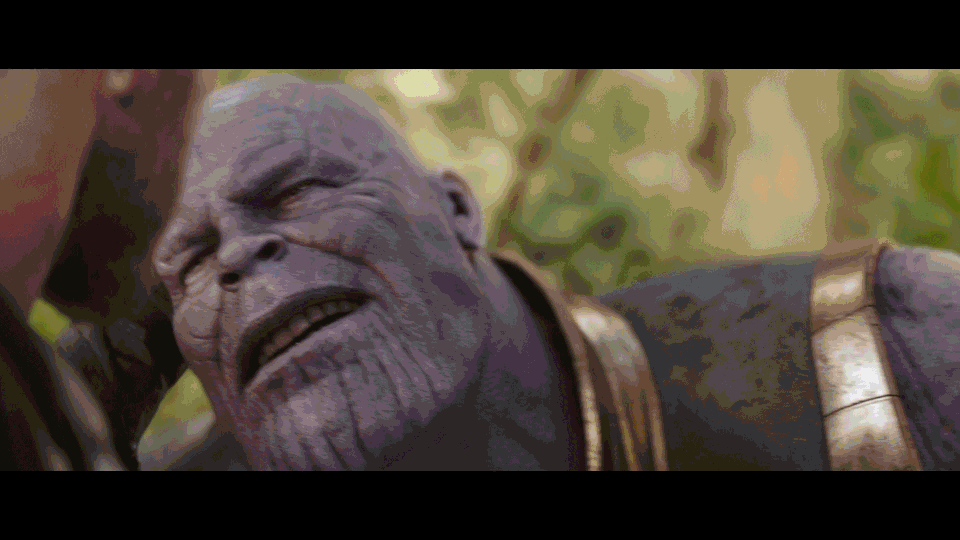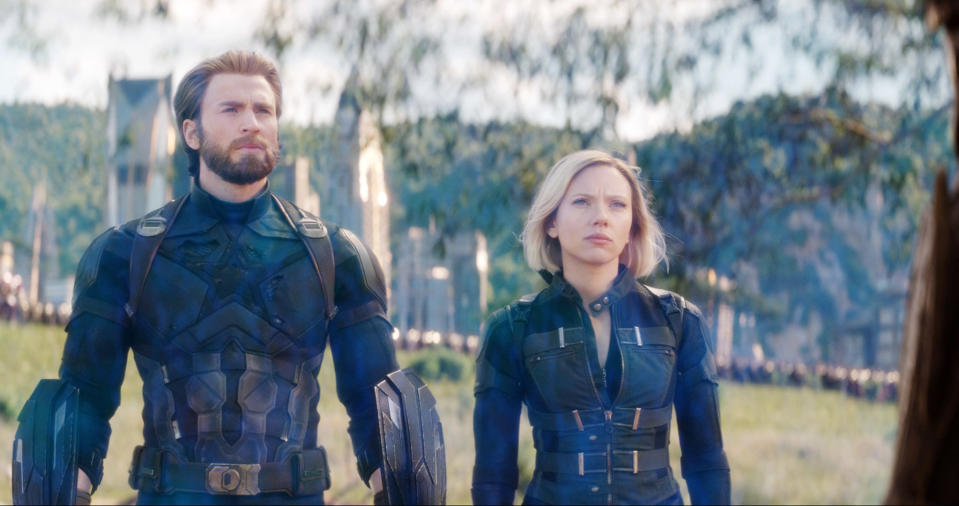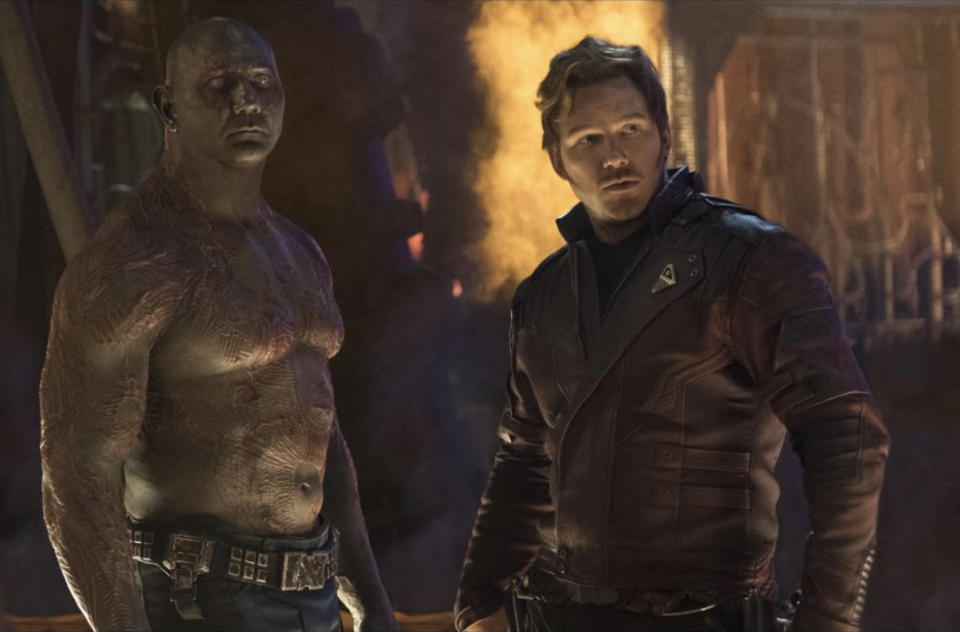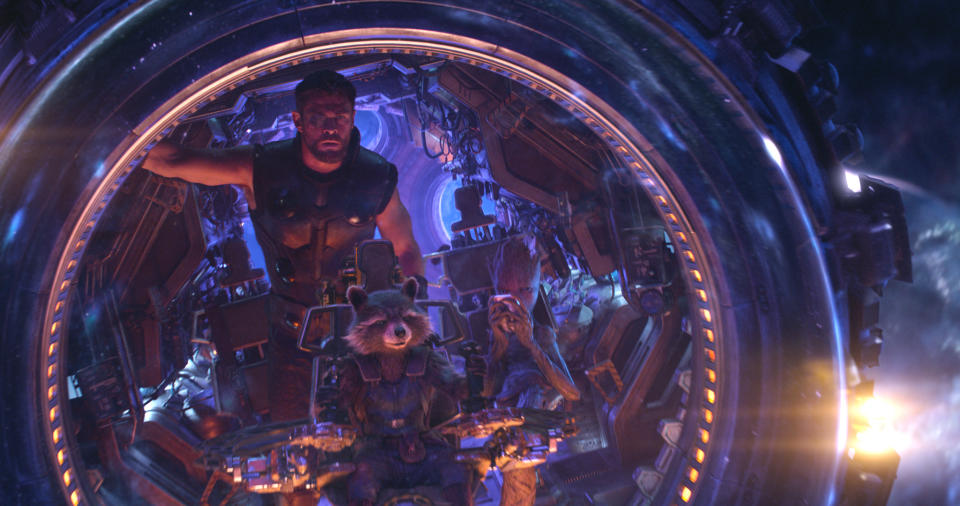Secrets of the Snap: How the 'Avengers: Infinity War' effects team turned the MCU to dust

With a mere snap of his fingers, Thanos reduced half of the Marvel Cinematic Universe to so much dust in the wind. But achieving the cataclysmic Snapture that closes out this summer’s all-star blockbuster Avengers: Infinity War wasn’t as simple as the mad Titan makes it look.
Infinity War‘s special effects supervisor Dan DeLeeuw tells Yahoo Entertainment that his team did a number of passes to make sure the heroes’ ashes would scatter just right. “It was definitely a process figuring out what the ash would be,” he says, noting that the first version of the Snapture drew on the power of all the Infinity Stones embedded in Thanos’s appropriately named Infinity Gauntlet. “We had always paid special attention to what the stones could do. For example, when Thanos uses the Space Stone to immobilize someone, there’s always this blue effect that’s around it. So we tried to use that same kind of rule for the end: If you break up a human, what are you breaking up?”

As DeLeeuw explains it, a hero like Tom Holland’s Spider-Man would break apart as follows: First the Soul Stone would disintegrate his soul, then the Power Stone would take care of the body, and the Space Stone would scatter those particles around. It was a mesmerizing effect — too mesmerizing, it turned out, for the film. “It stepped on every wonderful thing that the actors were doing,” DeLeeuw recalls. “We realized it had to become about less being more.”
So instead of incorporating all the stones, the F/X crew reconceived the Snapture so that each disappearance appears to be caused by the Power Stone specifically. “We were kind of leaving their corporeal form behind, and erasing them from the universe. It became less about the effect of the stones and more about what ways we can depict each person disappearing. Some people can hold on longer and some people go fast; that became something that fans have theories about. People have different theories about why Peter could last so long and someone like Drax went quickly.”
Irrespective of fan theories, there’s a practical reason why Holland took the longest to disappear. His abrupt farewell to his mentor, Tony Stark, is arguably the movie’s emotional high point, and that made it the perfect death for the F/X team to use as their test run as they perfected the vanishing effect.

“It’s the most pulling-at-the-heartstrings moment we had, and it was the one you were going to study the most because of how long it took for him to actually disappear,” DeLeeuw says. “We art-directed it around his performance; when he says, ‘I don’t feel so good,’ you want to make him start to go, and his hands go first, but you can’t do his face yet, because you gotta keep it for when he falls to the ground and Tony catches him.” Holland famously improvised his death scene, and, according to DeLeeuw, he did so without knowing what the finished effect would look like. “The mystery of what it would be might have helped their performance. Because their characters didn’t really understand what was happening either.”
So that’s the Snapture explained for you, but Infinity War contains a number of other scenes that are worthy of further study now that the film is on Blu-ray. We asked DeLeeuw and production designer Charles Wood to share some of their favorite secrets behind the film.
Watch the complete history of the Marvel Cinematic Universe from the dawn of time to the Snapture:
The beard abides
Henry Cavill famously required a digital shave to get rid of his Mission: Impossible mustache for Justice League. As DeLeeuw tells us, Chris Evans had the opposite issue for Infinity War, requiring some digital manscaping in order to keep Captain America’s two-year beard growth looking suitably heroic.

“It’s all him, but we had a few scenes where he had to massage it a little bit. We shot over such a long period of time, so he’d go away for a while and then come back and we’d have to tweak it.” DeLeeuw has gotten used to tweaking Cap in postproduction, having previously supervised The Winter Soldier and Civil War. “We’re always trying to figure out what’s the best way to show him being a super-soldier,” he says, pointing to one such shot during the Wakanda battle where Steve and T’Challa race ahead of their troops to be the first to confront the invading alien hordes. “That was a stunt double suspended on wires, and as the wires were carrying him down the hill, he was moving his feet as fast as he could. It was very similar to what they did with Superman: The Movie when young Clark Kent is running alongside the train.”
Getting cosmic
As the production designer behind the alien and cosmic realms glimpsed in Thor: The Dark World, Guardians of the Galaxy, and Doctor Strange, Wood has helped put the “Universe” in the Marvel Cinematic Universe. “It’s a big challenge to put a superhero in space, because if it was the real would, the film would be called The Right Stuff,” he tells us. “You want to be true to [reality] as much as you can, but you also want to take an audience into something glorious and spectacular.” With Infinity War, Wood was able to revisit some of the planets he previously helped create, including Knowhere, where Thanos acquires the Reality Stone from the Collector.
Knowhere made its onscreen debut in the first Guardians, and Wood credits writer-director James Gunn — who has since been fired from the franchise — with coming into that film with a strong vision for what that planet, and the rest of the outer reaches of space, would look like.

“James’s input on the film was paramount — he had a very strong image of how that film should have been from the get-go.” Working with Infinity War directors Joe and Anthony Russo awarded Wood the chance to revisit familiar territory in a new way. “They wanted to learn from what we’ve done before and go deeper into the bowels of Knowhere. We wanted to explore new parts of that space.”
Hammer time
We’re still mourning the untimely death of Thor’s trusty weapon, Mjolnir, but the Asgardian himself has a new sidekick: Stormbreaker, the hammer he forges on Nidavellir with the aid of Eitri and Groot. DeLeeuw wanted to communicate Stormbreaker’s awesome might by adding a flame around the hammer portion that burns even when it’s not in use.

“It’s a two-handed weapon, so he can get a bigger swing. Because it’s a Thanos-killing weapon, we wanted to make sure it had the same power to defeat the Infinity Stones. You get a sense of the difference between the visual representations of Mjolnir and Stormbreaker with that; this one is definitely on a higher level than Mjolnir.”
Avengers: Infinity War is on Blu-ray now.
Watch: The Captain America-Iron Man scene that wasn’t, and six other things you didn’t know about Avengers: Infinity War:
Read more from Yahoo Entertainment

